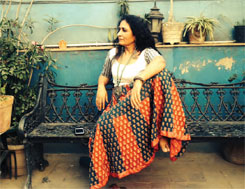 Seema Kohli’s art is a journey into self-discovery with the artist undertaking a journey that is motivating, relevant and communicative
Seema Kohli’s art is a journey into self-discovery with the artist undertaking a journey that is motivating, relevant and communicative
We are in the middle of our conversation when Seema Kohli, one of India’s best known contemporary artists, narrates a story. It was at a time when she was in Mumbai’s Jehangir Art Gallery where she once encountered a lady who spent hours looking at the artworks in the gallery. Kohli, out of curiosity, went to her and asked pointblank: “Do you understand any of the works on display?” The woman, eyes blinking, replied nonchalantly, “Maybe not. But I like the colours. I come here every day before taking my bus to work. Somehow, looking at these different artworks on display makes my day, leaves me feeling refreshed.”
The episode opened Kohli’s eyes to a brand new perspective — how different viewers choose to engage with artworks on display by artists in their own unique ways. For an artist who, through her rich repertoire, has always tried to explore a journey of “self”, this encounter with a simple, middle-class Mumbaikar showed Kohli how visual art had the ability and power to touch the lives of people deeply.
So what exactly is self-exploration for Kohli and when did this journey into the world of art begin? She knows it started early. “My family,” says Kohli, who has her forthcoming show in London in the next three months, “gave me a context to discover myself.” Her father, in particular, encouraged her.
“When I drew a bird,” she says, “it was already flying in my head.” It was, as she quips, her first encounter with The Moving Picture. The cosmic connections, the path of spirituality, the entire universe and the interconnectedness of everyone and everything, these issues were throbbing in Kohli’s mind and getting translated on canvas. “Through art, the more I thought about things, the more I was able to capture,” says the artist, a student of philosophy from Delhi University who would later finish her diploma in fine arts from South Delhi Polytechnic for Women, Delhi.
Concerned about the grim realities of life — the patriarchal society we live in, the attitude towards women being seen as weaker beings even today, the terribly unsafe environment — Seema’s leitmotif, the golden womb (Hiranyagarbha) — thus, began with the vision to celebrate the female form, its energy and the balance of both, the male and the female form that unifies the entire universe. Well-known curator Alka Pande, describing Kohli’s work, once wrote: “The Golden Womb is a celebration through which the supremacy of a female is established and how she procreates and keeps the journey of life, forever on. Her (Seema Kohli’s) work is symbolic of the progress and recycling of thought processes in the human mind, which is being seen as calmer, more mature and more serene, both in terms of palette and form. All her works are a gesture of the divine, a prayer to the eternal self, a way of mediation.”
“Ideologically,” says the artist who engages with art for a philosophical enquiry of life, “we are all in a womb… This conversation between you and me,” says Kohli who, through the visual language of art, tries to grasp the metaphysical truth of existence, “is also happening in a womb. From what you and I share in this moment of time, which is ensconced in a cosmic energy, there will be an idea that will emerge. There will be an exchange of an idea between us, through this conversation and from this idea, this talk, there will be something larger that will eventually emerge.”
Be it her paintings, sculptures, installations or videos, the aspect of continuity, awareness and public involvement is critical. A contemporary chronicler of the ancient myths and mythological figures of India, Kohli explores various themes, particularly spirituality and feminism, even though she finds it hard to be categorised or slotted in genres. “Art,” she says, “after all, is art.”
Deeply meditative, Kohli’s works, at first glance, burst with colour and sensuous compositions — a contemporary take on the fantastical world of stories, myths and legends. Employing the fundamental tenets of Buddhism, Hinduism, Sufism and Greek mythology, Kohli’s works need to be meditated upon. A visual storyteller, she weaves stories that are deeply personal but have a universal appeal at the same time.
One look at Kohli’s bronze work, The Rise of the Kundalini and you know what she means. In yogic theory, “rising kundalini” is the ultimate balance of chakras, which leads to enlightenment, bliss and awakening; think of a serpent lying coiled at the base of the spine, as this yogic theory explains, waiting to be awakened.
“My images grow with me, they converse and communicate, they are beings,” Kohli explains. Is there a way she defines her work? She ponders: “My work is uniquely my own… with expressions that are global. I am purely an artist — nothing more or less, neither woman nor man, neither ancient nor contemporary, inhabiting a universal consciousness and geography. For me, the process of art is about shedding all known prejudices, or labels.”
